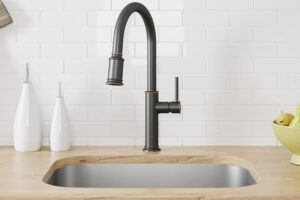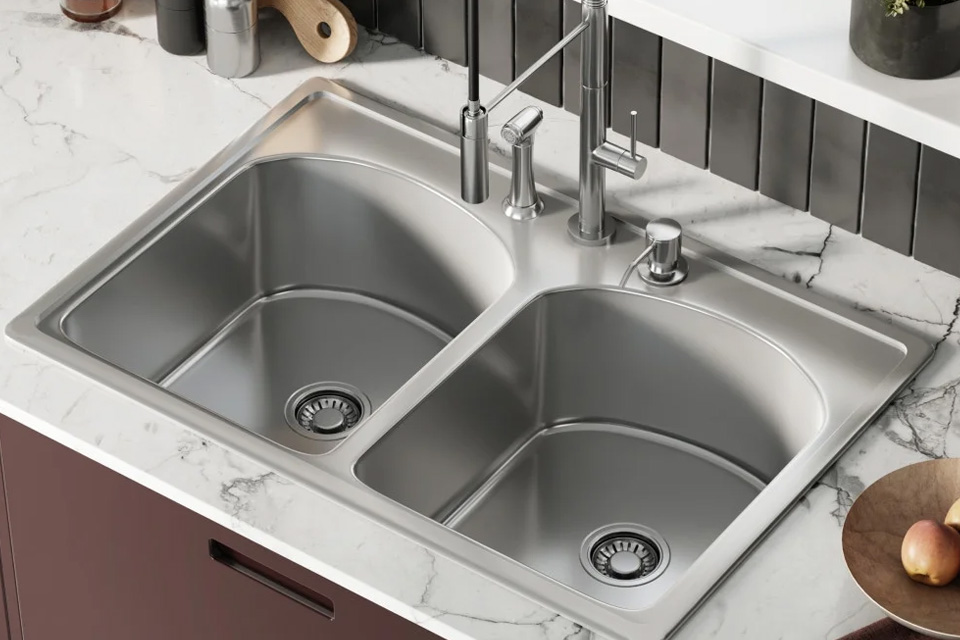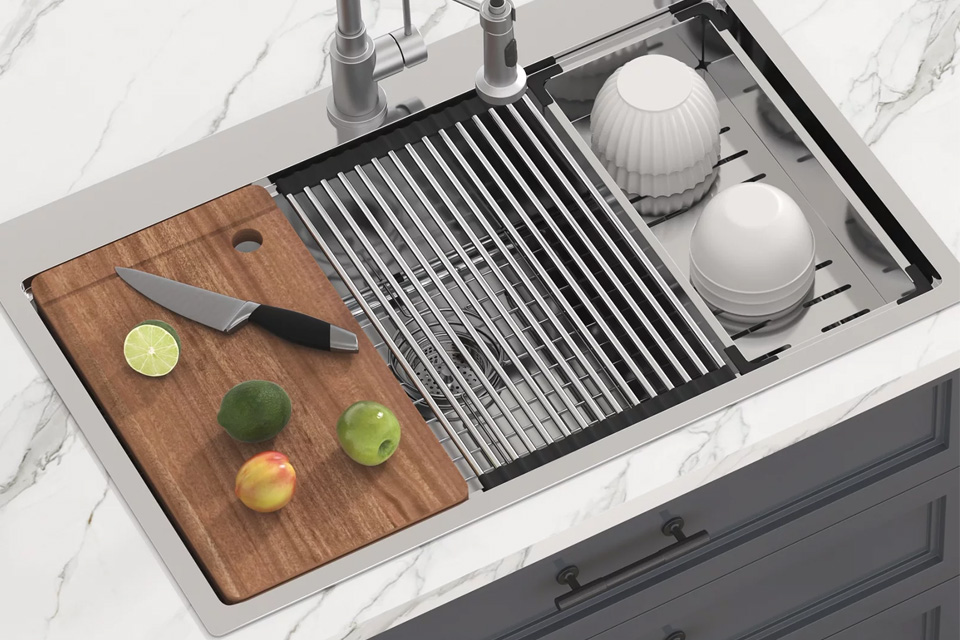
Why Choose an Undermount Sink
Table of Contents
Summary
Unlike traditional top-mount sinks, which feature a visible rim, undermount sinks are installed beneath the countertop, offering a streamlined appearance that enhances aesthetic appeal and facilitates easier cleaning. Their contemporary design not only contributes to a more spacious look but also minimizes areas where dirt can accumulate, making them particularly appealing to homeowners who prioritize hygiene and maintenance efficiency. The functional advantages of undermount sinks extend beyond their visual appeal. Their design allows for efficient use of space, enabling users to easily sweep food scraps directly into the sink without obstruction, and accommodating a variety of accessories like cutting boards and drying racks that maximize kitchen efficiency.
Furthermore, the deep basin designs commonly found in these sinks are ideal for washing large pots and pans, while ergonomic features help reduce strain during use.Despite their benefits, undermount sinks come with notable considerations, particularly regarding installation and cost. The installation process can be complex, often requiring professional expertise, which adds to the overall expense compared to more affordable top-mount options.Homeowners must weigh the higher upfront costs against long-term advantages, such as durability and lower maintenance requirements, which can make undermount sinks a worthwhile investment over time.
In addition to their practical and aesthetic merits, undermount sinks have sparked discussions about environmental impacts, particularly concerning the materials used. While stainless steel options are praised for their recyclability, some composite materials raise concerns regarding toxicity and sustainability. As such, selecting the right undermount sink involves balancing functionality, aesthetics, budget considerations, and environmental factors to meet individual preferences and values.
Design and Aesthetics
Undermount sinks offer a sleek and modern design that can significantly enhance the aesthetic appeal of a kitchen. One of the most notable characteristics of undermount sinks is their seamless integration with countertops, creating a cohesive and visually appealing look. When installed properly, these sinks blend seamlessly with surfaces such as granite, quartz, or solid surface countertops, allowing for a clean, modern appearance that is highly sought after in contemporary designs. The absence of a visible rim or lip not only contributes to a streamlined design but also makes cleaning easier, as there are no edges for food debris to accumulate. This characteristic is especially valuable in busy kitchens where practicality meets style.
Furthermore, undermount sinks can accommodate various reveal types—positive, negative, and zero—which allow for customization according to personal preferences and design goals. The zero reveal, where the countertop sits flush with the sink edge, is particularly coveted for its sleek, modern look.
In addition to their functional benefits, undermount sinks can also serve as statement pieces. Artisans are increasingly creating unique, one-of-a-kind sinks that double as functional art, allowing homeowners to express their individual style while enhancing the kitchen’s aesthetic. Whether opting for a classic stainless steel finish or a more adventurous design, the material and style of the sink can elevate the overall beauty of the kitchen space.
Ultimately, the design and aesthetic appeal of undermount sinks make them an excellent choice for those looking to enhance both the functionality and visual impact of their kitchen. With versatile styles and the ability to integrate seamlessly with countertops, undermount sinks can be a striking addition to any culinary space.
Functionality
Undermount sinks are celebrated for their superior functionality in both kitchen and bathroom settings. The design philosophy behind these sinks prioritizes seamless integration with countertops, thereby enhancing usability and aesthetic appeal.
Space Optimization
One of the most significant advantages of undermount sinks is their ability to maximize available space. By being installed beneath the countertop, they create a smooth, uninterrupted surface, which simplifies cleaning and allows for easy transfer of food scraps directly into the sink without the obstruction of raised edges. This design is particularly beneficial in smaller kitchens where every square inch counts, as it reduces clutter and enhances the overall workspace.
Enhanced Cleaning
The non-porous surface of undermount sinks, particularly those made from materials like quartz composite, contributes to a hygienic environment, making them easy to clean and maintain. The absence of seams where dirt and grime can accumulate means less effort is required to keep the sink area tidy. Furthermore, the deep basin design often found in undermount sinks allows for easier washing of large pots and pans, minimizing splashes and messes around the countertop.
Accessory Integration
Undermount sinks also lend themselves well to a variety of functional accessories. Custom-cut cutting boards can sit over the sink for efficient food preparation, while colanders can be placed directly within the sink for easy washing and draining of produce. Additionally, drying racks that rest over the sink can help conserve counter space, making the entire area more multifunctional. This adaptability is particularly advantageous in busy kitchens where space and efficiency are paramount.
Ergonomic Design
Ergonomics play a crucial role in the functionality of undermount sinks. Many designs feature rounded corners and deep basins, facilitating easier cleaning and reducing strain during use. Such features are especially helpful in maintaining a low-maintenance kitchen environment, as they minimize the need for intensive scrubbing and allow for quick wipe-downs after meal preparation.
Installation Process
Installing an undermount sink can be a complex procedure that often requires professional expertise. The installation must be executed with precision due to the significant weight that the sink bears from water and the garbage disposal.
Preparation for Installation
Before beginning the installation, it’s essential to prepare the countertop. This includes cutting out an appropriate hole for the sink. If the installer is not experienced, hiring a professional to make this cut is advisable, as it ensures a proper fit for the sink. Prior to applying any caulk or adhesives, confirm that the sink fits correctly into the prepared hole.
Steps for Installation
Apply Caulk: Using a caulk gun, apply caulk around the hole in the countertop where the sink rim will sit.
Insert Sink: Once the caulk is applied, gently place the sink into the hole. Ensure it is correctly positioned, and then apply additional caulk around the rim to seal the sink to the countertop securely.
Support Structures: The undermount sink is typically secured with adhesive, but it is crucial to include additional fasteners or clips to enhance stability. Relying solely on adhesive may lead to sink failure over time, especially under the weight of a garbage disposal.
Connecting Plumbing: After the sink is secured, the water supply lines must be connected to the faucet, followed by attaching the drain assembly. Plumber’s putty is often used to seal these connections, preventing leaks.
Considerations for Professional Installation
Given the intricate nature of undermount sink installation, many homeowners opt to hire professionals. Professional installers bring the necessary experience to ensure the job is done efficiently and correctly the first time, which can save time and prevent future issues. Furthermore, the materials used for the countertop significantly influence the installation process. Durable materials, like granite, are ideal for undermount sinks due to their ability to withstand the installation stresses involved.
Durability and Maintenance
Undermount sinks are celebrated for their durability and low maintenance requirements, making them a favored choice in modern kitchen and bathroom designs. Unlike topmount sinks, undermount sinks are installed beneath the countertop, offering a sleek appearance and facilitating easier cleaning. This design reduces the likelihood of water damage and mold formation, as there are no edges for water to collect and seep underneath.
Material Considerations
The longevity of an undermount sink significantly depends on the material chosen. Stainless steel and composite granite are among the most popular materials for undermount sinks due to their inherent durability and resistance to stains and scratches. Stainless steel sinks are known for their strength and ease of maintenance, while composite granite offers a blend of aesthetics and toughness, being virtually stain-proof, heat-proof, and impact-resistant. Choosing the right material not only contributes to the sink’s durability but also reduces the frequency of maintenance efforts required.
Regular Maintenance Practices
Maintaining an undermount sink involves regular cleaning to preserve its appearance and functionality. Homeowners are advised to implement a routine cleaning schedule that includes rinsing and wiping the sink with a microfiber cloth after each use, alongside using mild liquid soap for thorough cleanings. Avoiding harsh chemicals like bleach and ammonia is crucial, as these can damage the surface of the sink, leading to costly repairs or replacements.
Professional Maintenance and Inspections
While many maintenance tasks can be managed at home, certain situations warrant professional intervention. If persistent issues such as leaks or clogs arise despite DIY efforts, it is essential to consult a professional for accurate diagnosis and resolution. Regular check-ups by professionals can also help in identifying potential problems early, thus prolonging the sink’s lifespan and ensuring optimal performance.
Cost Analysis
When considering whether to invest in an undermount sink, cost plays a significant role in the decision-making process. Undermount sinks generally come with a higher price tag compared to topmount sinks, primarily due to the installation complexity and the materials involved. Typically, the price range for undermount sinks is between $200 to $700, while topmount sinks are more affordable, ranging from $100 to $500.
Installation Costs
The installation of undermount sinks can be particularly challenging, often requiring professional help. This necessity for skilled installation not only adds to the initial costs but also ensures that the sink is securely attached, as it bears considerable weight from both water and garbage disposal systems. In contrast, topmount sinks can be installed into various countertop materials with a simpler process, usually costing around $150 on average for installation.
Long-term Investment
While the upfront costs for undermount sinks are higher, they are viewed as a long-term investment. Their durability, modern aesthetic, and ease of cleaning may offset initial expenses over time, making them a more cost-effective choice in the long run. Homeowners should weigh the benefits of reduced maintenance and the potential for fewer repairs against the higher purchase and installation prices when making their decision.
User Preferences
When deciding between undermount and top-mount sinks, user preferences play a significant role in the selection process. Factors such as cleaning habits, aesthetic preferences, and budget considerations can greatly influence which sink type is deemed better for a particular kitchen setup.
Cleaning Preferences
Cleaning preferences are essential to consider when choosing between undermount and top-mount sinks. Top-mount sinks feature a lip that overlaps the countertop, which can trap dirt and debris, making it more challenging to clean around the edges. Users who prioritize ease of maintenance may find undermount sinks more appealing, as they offer a seamless transition between the sink and countertop, facilitating easier cleaning. The lack of crevices in undermount designs means there are fewer hidden areas for grime to accumulate, thus aligning with users who favor a low-maintenance kitchen environment.
Aesthetic Considerations
Aesthetics also play a crucial role in sink selection. Undermount sinks provide a modern and sleek appearance, allowing for a continuous surface that can enhance the overall kitchen design. Many homeowners prefer the minimalist look that undermount sinks offer, as they can elevate the ambiance of the kitchen and reflect the owner’s taste in interior design. Conversely, top-mount sinks are often perceived as more traditional and may appeal to users seeking a familiar, classic design in their kitchen space.
Budget Constraints
Budget considerations significantly impact user choices when selecting a sink type. Typically, top-mount sinks are less expensive and easier to install, making them a practical option for those with tighter budgets. Users who prioritize cost savings may opt for top-mount sinks, while those willing to invest more for aesthetics and functionality may choose undermount sinks despite their higher installation costs. Understanding these budget dynamics helps homeowners align their sink choice with their financial constraints and preferences.
Environmental Considerations
When choosing an undermount sink, it’s crucial to consider the environmental impact of the materials and practices associated with it. Opting for eco-friendly sinks can align with sustainable living values, contributing positively to both home aesthetics and environmental health.
Sustainable Material Choices
The choice of sink material plays a significant role in its eco-friendliness. Stainless steel sinks are often recommended for their recyclability; they can be repurposed into new items without losing quality, thus minimizing waste and resource consumption. In contrast, granite composite sinks, while aesthetically pleasing, may contain acrylic materials that can leach toxins over time, raising concerns for environmentally conscious consumers. Therefore, selecting materials that have a minimal carbon footprint, such as recycled or renewable options, is essential for reducing environmental impact.
Eco-Friendly Practices
Implementing eco-friendly practices in sink usage can further enhance sustainability efforts. For instance, using water-saving faucets can significantly reduce water consumption, while responsible disposal of kitchen waste helps to minimize landfill contributions. Moreover, the choice between undermount and farmhouse sinks should reflect an understanding of maintenance requirements, as some materials demand more frequent upkeep and harsher cleaning products, which can negate their environmental benefits.
Comments

Why Are Bathroom Sinks Made of Stainless Steel? Unveiling the Secrets of Sink Materials
Have you ever wondered why stainless steel is such a popular choice for bathroom sinks? In this comprehensive guide, we’ll explore the reasons behind this trend and compare stainless steel to other common sink materials.

Can a Single Bowl Sink Have a Garbage Disposal
A garbage disposal is a practical addition to any kitchen, and even if you have a single bowl sink, it’s a great fit.

A Complete Guide: How to Install a Farmhouse Sink
Installing a farmhouse sink is a fantastic way to transform your kitchen with both style and functionality. These iconic sinks, also known as apron-front sinks, have become increasingly popular due to their deep basins and elegant design.

Choosing the Right Sink for Your Bathroom Remodel: A Complete Guide
When planning a bathroom remodel, one of the most important decisions you’ll make is choosing the right sink.

Choosing Kitchen Countertops for Undermount Sinks: The Ultimate Guide
Undermount sinks have become a popular choice for modern kitchens, and finding the right countertop to pair with them is essential for both aesthetics and functionality.
Tags
Related Blog
Learn the newest trends and common knowledge from our blog in stainless steel sinks business.

A Complete Guide: How to Install a Farmhouse Sink
Installing a farmhouse sink is a fantastic way to transform your kitchen with both style and functionality. These iconic sinks, also known as apron-front sinks, have become increasingly popular due to their deep basins and elegant design.

The Best Ways to How to Clean a Stainless Steel Sink
Keeping your stainless steel sink clean and shiny not only enhances the look of your kitchen but also prolongs the lifespan of your sink.

Can a Single Bowl Sink Have a Garbage Disposal
A garbage disposal is a practical addition to any kitchen, and even if you have a single bowl sink, it’s a great fit.









